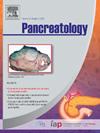尿酸和相关疾病在胰腺疾病的风险:英国生物银行的前瞻性研究。
IF 2.7
2区 医学
Q2 GASTROENTEROLOGY & HEPATOLOGY
引用次数: 0
摘要
背景:胰腺疾病,如急性胰腺炎(AP)、慢性胰腺炎(CP)和胰腺癌(PC)是主要的临床挑战,对健康有重大影响。血清尿酸(SUA)由嘌呤代谢产生,是反映代谢健康的重要生物标志物。高尿酸血症(HUA)定义为SUA bb0 7.0 mg/dL,与痛风、肾功能障碍和心脏代谢风险增加有关。SUA会引发炎症和氧化应激,导致胰腺损伤和癌症发病。这项研究是欧洲首个将尿酸(UA)疾病与胰腺疾病风险联系起来的队列研究。方法:这项前瞻性队列研究分析了363,778名英国生物银行参与者,中位随访14.2年,确定了1951例AP, 474例CP和2107例PC病例。我们使用Cox回归分析了UA疾病与胰腺炎风险之间的关系,报告了95%可信区间(CI)的风险比(HR)。Cox模型评估了SUA疾病与胰腺疾病(AP, CP, PC)的联系,并进行了全面调整。Cox分析采用分类变量和连续变量,Kaplan-Meier (KM)曲线采用分类变量。结果:SUA每升高1 mg/dL, AP发生风险显著增加:HR = 1.062 (95% CI: 1.020 ~ 1.105;P = 0.0036);Hr = 1.164 (95% ci: 1.019-1.330;P = 0.0254);HR = 1.478 (95% CI: 1.361-2.913);P = 0.0005)。在亚组分析和排除2年内的胰腺疾病病例和痛风诊断后,结果是稳健的。结论:我们的研究阐明了SUA在胰腺健康中的作用,并确定患有HUA或痛风的个体可能从胰腺疾病筛查中受益。本文章由计算机程序翻译,如有差异,请以英文原文为准。
Uric acid and related disorders in the risk of pancreatic diseases: A UK Biobank prospective study
Background
Pancreatic diseases, such as acute pancreatitis (AP), chronic pancreatitis (CP), and pancreatic cancer (PC) present major clinical challenges with significant health impacts. Serum uric acid (SUA), resulting from purine metabolism, is a significant biomarker reflecting metabolic health. Defined as SUA >7.0 mg/dL, hyperuricemia (HUA) is associated with gout, renal dysfunction, and increased cardiometabolic risk. SUA triggers inflammation and oxidative stress, contributing to pancreatic damage and cancer pathogenesis. This study represents the first European cohort linking uric acid (UA) disorders to pancreatic disease risk.
Method
This prospective cohort study analyzed 363,778 UK Biobank participants over a median follow-up of 14.2 years, identifying 1951 AP, 474 CP, and 2107 PC cases. We analyzed the association between UA disorders and pancreatitis risk using Cox regression, reporting hazard ratios (HR) with 95 % confidence intervals (CI). Cox models evaluated SUA disorders' links to pancreatic diseases (AP, CP, PC), with full adjustment. Both categorical and continuous variables were employed in the Cox analysis, while categorical variables were utilized for the Kaplan-Meier (KM) curves.
Result
For each 1 mg/dL increase in SUA, the risk of AP was significantly increased: HR = 1.062 (95 % CI: 1.020–1.105; P = 0.0036) in the overall population; HR = 1.164 (95 % CI: 1.019–1.330; P = 0.0254) in individuals with HUA; and HR = 1.478 (95 % CI: 1.361–2.913; P = 0.0005) in individuals with gout. Findings were robust in subgroup analyses and after excluding pancreatic disease cases within 2 years of HUA and gout diagnosis.
Conclusion
Our study clarifies the role of SUA in pancreatic health and identifies that individuals with HUA or gout may benefit from pancreatic disease screening.
求助全文
通过发布文献求助,成功后即可免费获取论文全文。
去求助
来源期刊

Pancreatology
医学-胃肠肝病学
CiteScore
7.20
自引率
5.60%
发文量
194
审稿时长
44 days
期刊介绍:
Pancreatology is the official journal of the International Association of Pancreatology (IAP), the European Pancreatic Club (EPC) and several national societies and study groups around the world. Dedicated to the understanding and treatment of exocrine as well as endocrine pancreatic disease, this multidisciplinary periodical publishes original basic, translational and clinical pancreatic research from a range of fields including gastroenterology, oncology, surgery, pharmacology, cellular and molecular biology as well as endocrinology, immunology and epidemiology. Readers can expect to gain new insights into pancreatic physiology and into the pathogenesis, diagnosis, therapeutic approaches and prognosis of pancreatic diseases. The journal features original articles, case reports, consensus guidelines and topical, cutting edge reviews, thus representing a source of valuable, novel information for clinical and basic researchers alike.
 求助内容:
求助内容: 应助结果提醒方式:
应助结果提醒方式:


